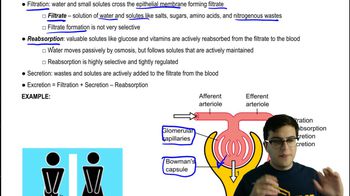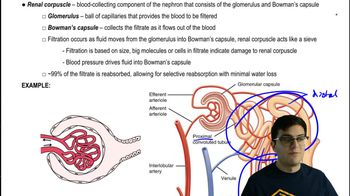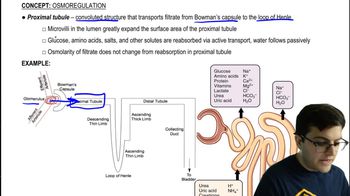Table of contents
- 1. Introduction to Biology2h 40m
- 2. Chemistry3h 40m
- 3. Water1h 26m
- 4. Biomolecules2h 23m
- 5. Cell Components2h 26m
- 6. The Membrane2h 31m
- 7. Energy and Metabolism2h 0m
- 8. Respiration2h 40m
- 9. Photosynthesis2h 49m
- 10. Cell Signaling59m
- 11. Cell Division2h 47m
- 12. Meiosis2h 0m
- 13. Mendelian Genetics4h 41m
- Introduction to Mendel's Experiments7m
- Genotype vs. Phenotype17m
- Punnett Squares13m
- Mendel's Experiments26m
- Mendel's Laws18m
- Monohybrid Crosses16m
- Test Crosses14m
- Dihybrid Crosses20m
- Punnett Square Probability26m
- Incomplete Dominance vs. Codominance20m
- Epistasis7m
- Non-Mendelian Genetics12m
- Pedigrees6m
- Autosomal Inheritance21m
- Sex-Linked Inheritance43m
- X-Inactivation9m
- 14. DNA Synthesis2h 27m
- 15. Gene Expression3h 20m
- 16. Regulation of Expression3h 31m
- Introduction to Regulation of Gene Expression13m
- Prokaryotic Gene Regulation via Operons27m
- The Lac Operon21m
- Glucose's Impact on Lac Operon25m
- The Trp Operon20m
- Review of the Lac Operon & Trp Operon11m
- Introduction to Eukaryotic Gene Regulation9m
- Eukaryotic Chromatin Modifications16m
- Eukaryotic Transcriptional Control22m
- Eukaryotic Post-Transcriptional Regulation28m
- Eukaryotic Post-Translational Regulation13m
- 17. Viruses37m
- 18. Biotechnology2h 58m
- 19. Genomics17m
- 20. Development1h 5m
- 21. Evolution3h 1m
- 22. Evolution of Populations3h 52m
- 23. Speciation1h 37m
- 24. History of Life on Earth2h 6m
- 25. Phylogeny2h 31m
- 26. Prokaryotes4h 59m
- 27. Protists1h 12m
- 28. Plants1h 22m
- 29. Fungi36m
- 30. Overview of Animals34m
- 31. Invertebrates1h 2m
- 32. Vertebrates50m
- 33. Plant Anatomy1h 3m
- 34. Vascular Plant Transport2m
- 35. Soil37m
- 36. Plant Reproduction47m
- 37. Plant Sensation and Response1h 9m
- 38. Animal Form and Function1h 19m
- 39. Digestive System10m
- 40. Circulatory System1h 57m
- 41. Immune System1h 12m
- 42. Osmoregulation and Excretion50m
- 43. Endocrine System4m
- 44. Animal Reproduction2m
- 45. Nervous System55m
- 46. Sensory Systems46m
- 47. Muscle Systems23m
- 48. Ecology3h 11m
- Introduction to Ecology20m
- Biogeography14m
- Earth's Climate Patterns50m
- Introduction to Terrestrial Biomes10m
- Terrestrial Biomes: Near Equator13m
- Terrestrial Biomes: Temperate Regions10m
- Terrestrial Biomes: Northern Regions15m
- Introduction to Aquatic Biomes27m
- Freshwater Aquatic Biomes14m
- Marine Aquatic Biomes13m
- 49. Animal Behavior28m
- 50. Population Ecology3h 41m
- Introduction to Population Ecology28m
- Population Sampling Methods23m
- Life History12m
- Population Demography17m
- Factors Limiting Population Growth14m
- Introduction to Population Growth Models22m
- Linear Population Growth6m
- Exponential Population Growth29m
- Logistic Population Growth32m
- r/K Selection10m
- The Human Population22m
- 51. Community Ecology2h 46m
- Introduction to Community Ecology2m
- Introduction to Community Interactions9m
- Community Interactions: Competition (-/-)38m
- Community Interactions: Exploitation (+/-)23m
- Community Interactions: Mutualism (+/+) & Commensalism (+/0)9m
- Community Structure35m
- Community Dynamics26m
- Geographic Impact on Communities21m
- 52. Ecosystems2h 36m
- 53. Conservation Biology24m
42. Osmoregulation and Excretion
Osmoregulation and Excretion
Problem 12
Textbook Question
Textbook QuestionFish and other aquatic organisms are exposed to many types of water pollutants, including metals such as aluminum. Although a low level of aluminum is found in unpolluted water, many lakes and streams have an increased level because of mining, sewage treatment, and accidental spills of toxic materials. Aluminum pollution can result in mass fish die-offs. In a laboratory, scientists exposed freshwater bony fish (Prochilodus lineatus) to water with a high level of aluminum and compared their blood osmolarity to that of fish exposed to water with a normal aluminum level (control). The results of the experiment are shown here (asterisks indicate P<0.05 between control and treated groups at a given time; BioSkills 3). Do the data support the hypothesis that aluminum interferes with osmoregulation in freshwater fishes? Explain.
 Verified step by step guidance
Verified step by step guidance1
Step 1: Understand the problem. The question is asking whether the data supports the hypothesis that aluminum interferes with osmoregulation in freshwater fishes. Osmoregulation is the process by which organisms regulate the osmotic pressure of their body fluids to maintain the homeostasis of the body's water content. In this case, the scientists are comparing the blood osmolarity of fish exposed to high levels of aluminum to those exposed to normal levels.
Step 2: Analyze the data. Unfortunately, the problem does not provide the actual data from the experiment. However, in a real-life scenario, you would look at the blood osmolarity levels of the fish exposed to high levels of aluminum and compare them to the control group. If the blood osmolarity levels of the fish exposed to high levels of aluminum are significantly different from the control group, this could indicate that the aluminum is interfering with osmoregulation.
Step 3: Understand the significance level. The asterisks in the data indicate a P-value of less than 0.05. This means that the difference between the control and treated groups is statistically significant, and the likelihood that the difference is due to chance is less than 5%. If there are asterisks next to the data points comparing the control and treated groups, this would support the hypothesis that aluminum interferes with osmoregulation.
Step 4: Draw conclusions. Based on the statistical significance of the data, you can conclude whether or not the data supports the hypothesis. If the blood osmolarity levels of the fish exposed to high levels of aluminum are significantly different from the control group, and the P-value is less than 0.05, then the data would support the hypothesis that aluminum interferes with osmoregulation in freshwater fishes.
Step 5: Communicate your findings. After analyzing the data and drawing conclusions, you would then communicate your findings in a clear and concise manner, explaining whether the data supports the hypothesis and how you arrived at your conclusion.
Recommended similar problem, with video answer:
 Verified Solution
Verified SolutionThis video solution was recommended by our tutors as helpful for the problem above
Video duration:
1mPlay a video:
Was this helpful?
Key Concepts
Here are the essential concepts you must grasp in order to answer the question correctly.
Osmoregulation
Osmoregulation is the process by which organisms regulate the balance of water and solutes in their bodies to maintain homeostasis. In freshwater fish, this involves the uptake of water through their skin and gills while excreting excess salts. Disruption in osmoregulation can lead to physiological stress, affecting the fish's ability to survive in their environment, especially when exposed to pollutants like aluminum.
Recommended video:
Guided course

Osmoregulation and Nitrogenous Waste
Effects of Aluminum on Aquatic Life
Aluminum is a toxic metal that can accumulate in aquatic environments, primarily due to human activities such as mining and industrial discharges. Elevated levels of aluminum can impair the gill function of fish, leading to reduced oxygen uptake and disrupted ion balance. This toxicity can result in physiological changes, including altered blood osmolarity, which is critical for understanding the impact of aluminum on fish health.
Recommended video:
Guided course

Introduction to Aquatic Biomes
Experimental Control and Comparison
In scientific experiments, a control group is essential for establishing a baseline for comparison. In this study, the control group consisted of fish exposed to normal aluminum levels, while the experimental group was subjected to high aluminum levels. By comparing the blood osmolarity of both groups, researchers can determine the specific effects of aluminum on osmoregulation, providing evidence to support or refute the hypothesis.
Recommended video:
Guided course

Negative & Positive Controls

 7:16m
7:16mWatch next
Master Osmoregulation and Nitrogenous Waste with a bite sized video explanation from Jason Amores Sumpter
Start learningRelated Videos
Related Practice


































































